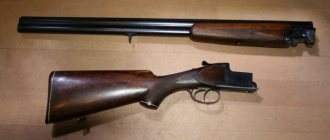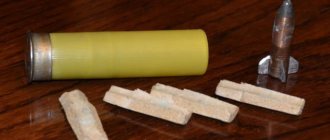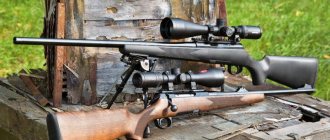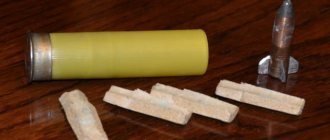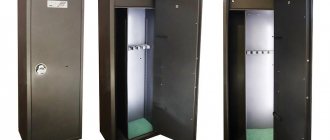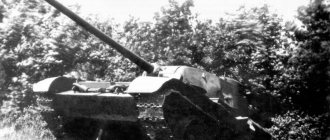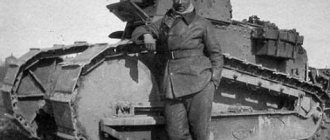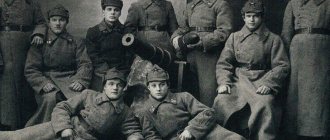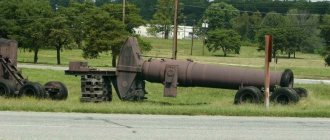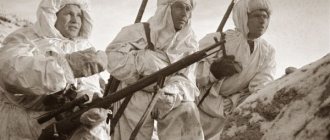IZH-27
This is the most famous gun of the brand.
It is rightly called the pride of “Izh Mekha”. Everyone wants to get their hands on these premium devices. Having it in your arsenal is prestige for any hunter. The model was created under the leadership of Klimov and has been mass-produced since 1973. Today it is the most modernized model. So, the shape of the stock and fore-end of the weapon was changed. For accuracy of shots, a ventilated aiming bar has been introduced. The shape of the box at the junction with the stock has been changed.
Over 30 years of production, over 1.6 million IZH-27 of all modifications were sold. This makes this model the most common model of hunting rifle in Russia. This is one of the reasons why it is often called the "people's gun."
IZH-54
A very popular option.
Today such a gun is rare, although it is still found in the collections of individual hunters. It was developed in 1954 and produced until 1969. The model is notable for being a development of the German Sauer-8 shotgun. Despite the fact that the issues of 54 have long been discontinued, an incredible number of them were riveted in the USSR - more than 477 thousand copies. Although later a whole family of more successful guns appeared based on the IZH-54, this model enjoys considerable respect among hunters.
Sports analogue of VPO-205 00-SP
The modernized version of the 12-gauge "Vepr" shotgun is one of the most expensive modifications of domestic production. The carbine is designed for a reinforced Magnum-76 cartridge, has a high level of reliability, and operates reliably in the most difficult operating conditions.
VPO-205 00-SP is equipped with a telescopic butt, a muzzle brake compensator, and an integrated Picatinny rail, which is used for mounting additional accessories. The design was developed taking into account the recommendations of professional athletes, has a quick magazine reload button and a double-sided key-type fuse.
What is the most expensive weapon in the world?
According to experts, the most valuable hunting rifle is considered to be the model of the Swedish arms company VO Vapen. It was founded by master Viggo Olsson in 1977.
Today this company is the main supplier of the Swedish king Carl XVI Gustav. In addition, the products were highly appreciated by Arab sheikhs: VO Vapen supplies the Middle Eastern markets with its ultra-exclusive products. Due to the fact that the guns are hand assembled, production is limited to a few very luxurious and high quality guns per year. The latest new product from the company is the VO Falcon Edition rifle. Vapen only produced one rifle unit. It is planned to produce 4 more pieces. The product costs 820 thousand dollars.
TOZ-80
Representative of hammer-fired weapons. Refers to 2-barreled hunting weapons with horizontally paired barrels. The caliber of the gun is 12 mm. Produced since 1986 in strictly limited quantities.
Outwardly it is very similar to TOZ-BM. Technical characteristics are similar to the 66: barrels are 711 mm long, barrels and chambers are chrome-plated. Has detachable barrels and forearm. Triple locking - on 2 under-barrel hooks with a frame and a cross bolt. The barrels are made for paper cartridges.
The triggers are equipped with a release and have safety cocks. At this time it is not listed in mass production. Thanks to the necessary changes, the model became a good replacement for all its predecessors, leaving only the positive features of the past.
There was another arms factory in the Soviet Union with a good reputation. We are talking about the products of the Izhevsk Mechanical Plant. The advantages of this enterprise are the variety of products. Here they successfully produce single-barreled and modifications of 2-barrel shotguns with different bores.
TOZ-BM
Powerful thing.
The creation of the Tula arms factory from 1957. They made guns for calibers 16 and 20. The barrel length of this beauty was 700 and 725 mm, respectively. The gun weighed about 3.25 kg. A serious drawback of the gun was the lack of chrome plating, which made it susceptible to corrosion. Despite this unpleasant fact, it enjoyed considerable popularity. Today, it is most often found in the TOZ-63 iteration, the main difference of which is the presence of a chrome-plated barrel.
Smooth-bore semi-automatic machines
No matter how good a shooter a hunter is, even the most experienced one, everyone makes mistakes. And here one more cartridge is just missing. Of course, multi-shot automatic rifled weapons were invented quite a long time ago. But every second person dreamed of a multi-shot smoothbore shotgun with automatic reloading.
They have been working on the creation of a smooth-bore semi-automatic shotgun at the border for a long time. Back in 1898, John Moses Browning invented his smooth-bore five-shot semi-automatic, called the Auto-5. Subsequently, the improvement of hunting semi-automatic devices was carried out constantly by many companies and now there are decent reliable models that can be purchased in Russia. But these are quite expensive guns and not everyone can afford them.
In the USSR, the domestic hunting semi-automatic MTs 21-12 was created only in 1965 at the Tula Arms Plant. It was a very successful design. its production continued for more than 50 years. Since 2002, it was replaced by a more modern model, Bekas Auto, and somewhat later, Bekas M Auto, which is still in production. At the same time, the Izhevsk Mechanical Plant developed the MP-153 smooth-bore semi-automatic machine intended for commercial hunting, sports shooting, self-defense and law enforcement. As a result of further improvement, a new model MP-155 appeared not long ago.
Semi-automatic devices are in constant demand as a more advanced weapon and, despite the fairly high cost, can be recommended for novice hunters who decide to take up hunting thoroughly.
Self-loading shotguns MP-153 and MP-155
Caliber - 12/76 Manufacturer - IZHMEKHChamber - 12/70, 12/76 "Magnum", 12/89 "Super Magnum" Magazine - 12/76 - 4 rounds, 12/89 - 3 rounds Barrel length - 610, 660, 710, 750 mm Weight - 3.4 kg. Bed - wood, plastic, with a folding stock. Produced since 2000. Price from 20,000 rubles.
MP-153 has been produced at IZHMEKH since 2000. This is the first domestic self-loading shotgun chambered for 12/89 cartridge. Can be used for almost all cartridges from 12/70 to 12/89. Reloading scheme due to the removal of powder gases. Strong bolt locking due to direct engagement with the barrel. The receiver is made from a single piece of aluminum. The bore, chamber, piston, gas chamber and magazine tubes are chrome plated. Valve and piston rings made of stainless steel. Trigger trigger mechanism in the form of a detachable unit. A system that prevents shots being fired when the bolt is not fully locked and a non-automatic safety that blocks the trigger.
The improvement of this gun continued and in 2010, based on the MP-153, a new model MP-155 was released. It has become lighter, an arch-type sighting bar has been used, the shock absorber has been improved, the trigger travel has been reduced, the size of the safety button has been increased, it has become possible to adjust the height of the butt comb and install optical or collimator sights. There is a built-in cut-off mechanism, thanks to which you can turn off the supply of cartridges from the magazine and reload the gun manually. There is a left-handed model. MP-153 has become on par with many foreign brands.
MC-21-12
The first is automatic.
A well-known Soviet gun based on the Belgian Browning Auto 5. The 21-12 is remarkable if only because it became the first Soviet self-loading hunting rifle! The weapon's automatic operation is based on the recoil mechanism of a spring-loaded barrel and a longitudinally sliding bolt. These were produced only in 12 caliber, in contrast to the basic MTs-21 shotgun, which was made in three calibers. More than 300 thousand of these were produced in the USSR.
Fabbri and Holland Royal Deluxe
The first model is a double-barreled shotgun made in Italy. According to experts, the weapon has a very complex and sophisticated mechanism. During the manufacturing process, Fabbri gunsmiths use unique vacuum-thermal technology.
In order to increase the service life of the trunks, craftsmen apply a diamond carbon coating to them. Judging by the reviews, the only disadvantage of this rifle unit is not the price, which is only 150 thousand dollars, but the fact that the customer has to wait five years for the weapon. The Royal Deluxe hunting double-barreled shotgun is produced a little faster - in just 850 hours.
The gun is personalized with engraving, which is a true work of art. The model costs 228 thousand dollars. Another expensive toy is the Sauer, which we recommend reading about here: https://truehunter.ru/425453a-ohotniche-ruje-zauer-modeli-harakteristiki-foto.
Pump-action shotguns
The pump-action shotgun was invented back in 1882 by the American inventor Christopher Spencer. The reloading scheme in the design of this gun is carried out by moving the under-barrel rail. This option turned out to be so successful that many gunsmiths began to use it. It was this “sliding forend” principle that John Moses Browning applied in the creation of many of his models. Now this design is used by all leading arms companies. The main advantage of this type of weapon is a fairly capacious magazine and quick reloading of the spent cartridge case. This type of weapon was initially conceived not as a hunting weapon, but as a weapon for police and special services, and was made mainly with a pistol-type handle, sometimes with a folding butt. But over time, these guns began to enjoy wide popularity among farmers and hunters, and for convenience they began to be produced with ordinary gun stocks.
Our domestic weapons manufacturers only developed the domestic IZH-80 shotgun designed for special forces in the late 80s. But after perestroika, in 1994, this gun, with minor alterations, began to be mass-produced at the Izhevsk Mechanical Plant under the IZH-81 brand. The gun was made with a permanent or folding stock and an under-barrel tubular magazine; there was also a model with a box magazine. IZH-81 became quite popular and was successfully sold both in the domestic and foreign markets. The reason for this popularity of the Russian pump-action was its very low price compared to foreign analogues. In this form, the IZH-81 was produced for more than ten years in different modifications and with different barrel lengths.
Nowadays there are quite a few types of pump-action shotguns from different manufacturers, including domestic ones. They are purchased mainly for protection, but some also use them for hunting, although due to their specific nature they are not always convenient, especially against fast-moving targets. After reloading, the gun moves away from the line of sight and you have to take aim again, wasting precious time. But nevertheless, we will present several models of this type of weapon.
MP-133 smoothbore pump-action shotgun
Caliber - 12/76; 12/89 Manufacturer - IZHMEKHCartridge - 76/89 mm Magazine - under-barrel tubular for 4 or 6 rounds Barrel length - 750 mm; 710 mm; 660 mm; 610 mm; 540 mm; 510 mm Muzzle constrictions - permanent or replaceable chokes System - smooth-bore multi-shot, with reloading by handguard Locking mechanism - engagement of the bolt with the barrel Case extraction mechanism - extractor Sight - ventilated sighting bar and front sight Safety - protection from firing when the bolt is not fully locked - locking prevents inadvertent unlocking of the bolt before firing a, or non-automatic safety blocking the trigger. Finish - blued parts, chrome-plated channels. Receiver - aluminum alloy. Length - 1280 mm, with a barrel length of 750 mm. Stock - walnut, birch or beech. Weight - 3.3 kg. Price from 12,000 rubles.
The MP-133 pump-action smoothbore multiple-charger has been produced since 2000 at IZHMASH. You can use 12 gauge cartridges of any length from 70 to 89 mm. The magazine holds 4 rounds, with an extension 6 rounds. The barrels are chrome plated and have a ventilated rib. Has a slide stop mechanism and a push-button safety. The bolt is engaged directly with the barrel, which ensures the strength and durability of the locking, and also relieves the receiver when fired. Receiver made of aluminum alloy.
The trigger mechanism is trigger. There is an anti-kickback switch that allows you to remove a cartridge chambered into the chamber. Replaceable choke tubes are provided for firing lead and steel shot. Aimed firing range is up to 50 m. Firing accuracy at a distance of 35 m is at least 50%. Available in various versions of the butt and forearm: wood, plastic, with a folding butt, with a pistol grip without a butt. By the way, it is the pump-action multi-loader that is considered the best gun option for self-defense.
The history of the appearance of the IZH-12 gun
The Izh-12 double-barreled shotgun with vertically positioned barrels traces its ancestry to the IZH-59 “Sputnik” shotgun, which even many old hunters do not remember. The IZH-59 was produced for only 2 or 4 years (different sources say differently), and soon this gun was replaced by a new development, which became the IZH-12 gun. The second “vertical” of the Izhevsk plant was devoid of many of the shortcomings of its predecessor.
The Soviet designer Klimov managed to create a new model that was suitable not only for hunting, but also for sport shooting. The IZH-59 differed from most other models of guns that were used for sport shooting by its light weight. In addition, the connections of the barrels on the IZH-59 are made using couplings, which almost completely eliminates the possibility of deformation of the barrel block when the barrels are heated during intense fire (even if the barrels are heated unevenly, the barrel block is not deformed). Due to this, the designer managed to create a fairly light gun, which had excellent combat and accuracy.
Currently, there is an opinion that the connection on the couplings does not ensure combat accuracy, it is for this reason that the IZH-59 was replaced by the more advanced model IZH-12, but the majority of IZH-59 owners (of which there are few left) prove in practice that their guns shoot quite accurately. Most likely, problems with accuracy arose after using more powerful cartridges, for which this gun was clearly not designed to be used.
The IZH-12 model, which appeared in 1962, quickly gained enormous popularity among domestic hunters throughout the entire Soviet Union. Moreover, this gun is still popular today. IZH-12 is a cheap and reliable double-barreled shotgun, which is characterized by excellent firing and accuracy. The gun barrels were shortened slightly, now their length was 730 mm. The composite forend, which was installed on the IZH-59, was replaced with a solid one. This design decision was clearly unsuccessful, as the forend became very brittle. The design of the IZH-12 included trigger interceptors, which the IZH-59 lacked.
Single-barreled shotgun
This is the simplest of all types of hunting rifles. Usually inexpensive, but at the same time very reliable and with a good fight
The gun is quite light in weight, which is very important. Easy to disassemble for cleaning and maintenance
The main disadvantage is that in case of a miss, the hunter does not have time to fire a second shot due to the need to reload the gun. However, these guns are valued by experienced shooters who believe that a hit should be made on the first shot.
Single-barreled shotgun MP-18 MN
Caliber - 12/76 Weight - 3 kg Manufacturer IZHMEKH Barrel length - 71 cm Stock - wood Price from 7500 rubles
Due to its simplicity and reliability, it has a high degree of security. The trigger mechanism mounted in the gun box is characterized by a simple design and high reliability. The mechanism for locking the barrel bore with a swinging lever is also very simple and convenient, it ensures quick reloading.
The gun is equipped with an ejector - a mechanism for automatically ejecting spent cartridges, which can be easily turned off if desired. When the barrel is reopened, the ejector turns on automatically. The gun has excellent balancing and therefore it is very flexible, that is, you can quickly take aim with it offhand.
MP-18 12/76 can be considered the most successful of the Russian single-barreled shotguns, popular both in Russia and abroad. Produced since 1964, it has undergone several modifications, but is still rightfully considered one of the best in its class.
This gun is suitable for hunting various birds: goose, duck, pheasant, hazel grouse, wood grouse, small and medium-sized animals: hare, fox, arctic fox and other game for which hunting is permitted in our country. When used, the bullet can also hit large animals: wild boar, deer, jackal, wolf. However, it should be remembered that for safety reasons, it is better to hunt wild animals with a double-barreled or repeating shotgun.
Single-barreled shotgun made in Türkiye Hatsan Optima SB-W cal.20/76
Manufacturer Hatsan Turkey Caliber 20/76 Model Optima Type - Single-barrel fracture Barrel 71 cm. Choke constant choke. Stock - walnut. Full length 111 cm. Weight 2.5 kg. Sight - rail with front sight. Receiver - chrome plated. Price from 12,000 rubles.
Turkish shotguns of the Optima series have long been recognized in our market. One of them, the Hatsan Optima SB-W cal. 20/76, is a classic single-barrel shotgun of fairly high quality at a relatively low price.
Of particular value is the fact that its barrels are made of steel with the addition of nickel, chromium and molybdenum. This greatly protects the gun from corrosion. The barrels are chrome-plated both inside and outside, which increases their wear resistance. The outer surface of the barrel is covered with black chrome, which, in addition to protecting against corrosion, gives the weapon an elegant look.
Trigger mechanism of hammer type. The cocking of the hammer is almost silent. The trigger release when canceling a shot is very easy. Stable accuracy of shot of any size. Despite the fact that the single-barrel Hatsan Optima SB-W cal. 20/76 has a 20 caliber, since it is designed for the European market where 16 or 20 caliber guns are more often used, this is a quite effective weapon that allows you to hunt any bird and animal, including including duck, goose, pheasant, bustard, beaver, hare, fox, deer, etc.
The first Soviet guns, part 2
On April 13, 1922, the recreated IOZ hunting rifle workshop began its activities with the production of shotguns based on the Berdan rifle. Soon the production of hammerless double-barreled shotguns of the Pieper system resumed. Shotguns and rifled Siberian rifles with capsule locks were also produced. In 1926, production began of the IZH-5 single-barreled shotgun, a modernized American shotgun, initially produced under the name “Izhevsk-Johnson” in different calibers: from 12 to 28. In 1926, 8,100 pieces were produced, in 1929 - 80,054 pieces, and in 1934 - 212672 pieces. Models 2 and 3 of the A.A. sporting rifle were also produced. Smirnsky. In 1924, the factory of the Regional Union of Hunters was opened, and in 1930 the Dynamo weapons factory began operating, where in 1934 more than 34 thousand hunting rifles were manufactured by a small team of 172 people (N.L. Izmetinsky, L.E. Mikhailov, “Izhevsk weapons”, 1995) In May 1930, representatives of the German arms industry visited Izhevsk. The conversation included assistance in organizing the production of modern hunting weapons.
Shotgun IZH-5: 1-strike; 2- striker spring; 3-trigger; 4-trigger; 5-trigger spring; 6-pusher; 7-spring.
Changes in economic policy can be traced by the change in the name of the Tula arms factory: First arms factories R.S.F.S.R. GAU NK for military affairs of the RSFSR (October 31, 1918 - 1919), The first weapons factories of the Central Board of Artillery Factories of the Council of Military Industry of the RSFSR (1919 - 1922), The first weapons factories of the Main Directorate of Military Industry of the Supreme Economic Council of the RSFSR (1922 - 06/08/1923), The first weapons factories factories of the USSR of the Military Industry Production Association "Voenprom" VSNKh (06/08/1923 - November 1926), The first weapons factories of the USSR of the State Arms and Machine Gun Trust "Rouge" VSNKh (November 1926 - 1930), The first weapons factories of the State All-Union Gun - Weapons - Machine Gun Association Supreme Economic Council of the USSR (1930 - 01/05/1932), The first weapons factories of the Main Military Mobilization Directorate of the People's Commissariat of Heavy Industry of the USSR (01/05/1932 - 1934), The State Union First Weapons Plant - since 1934. The collapse of the NEP and the transition to a planned economy with the beginning of the first five-year plan (1929 - 1933) briefly postponed the issue of creating a domestic gun for sport hunting. Over time, attitudes towards amateur hunters themselves and their needs began to change for the better. If the first hunting organizations appeared spontaneously and existed for the most part in the Universal Education system, created in 1918 for the on-the-job training of the mobilization reserve of the army, then in the early 20s territorial organizations of hunters began to emerge. At the end of 1921, hunting and fishing commissions appeared in military districts. Since April 1930, the magazine “Fighter – Hunter” began to be published, with which S.A. collaborated. Buturlin. On October 17, 1933, the Revolutionary Military Council of the USSR decided to create the All-Army Military Hunting Society and its branches in the districts. In May 1934, the first conference of military hunters took place in Moscow. I think the importance of hunting in terms of preparation for military service was deliberately exaggerated, but there seemed to be no other way to revive amateur hunting in the country. During the time of the planned economy, perhaps only the All-Army Military Hunting Society, which in 1937 had more than 40 thousand members in its ranks, its own shooting sports and its own printed organ, could at the appropriate level voice the problems of hunting enthusiasts, among which the first place was lack of modern domestic hunting rifles.
And such a gun appeared in 1932 in Izhevsk under the name IzhBK. The author is considered to be Morozov, a technician at the arms factory. This surname was named V.E. Markevich, but neither the fate of this man, nor even his initials are known. The Tula State Weapons Museum houses a single-barreled 16-gauge shotgun designed by Morozov, assembled in the IOZ hunting rifle workshop in 1931.
Morozov single-barreled shotgun 16 caliber. 1931
“The barrel of the gun is cylindrical, with a coupling in the breech, folds down, and is detachable. The barrel bore is locked by a frame that fits into the recess of a large under-barrel hook. The release lever is lower, the tail part is combined with the trigger guard. The sighting device consists of a round front sight and a slot on the top of the receiver. The receiver is cranked, with a straight rear edge; There is a safety button on the shank. The trigger is internal. An extractor in the form of a shaped plate with a cylindrical rod. The stock is wooden, consists of a short detachable forend with a lever latch, a semi-pistol neck and a flat butt. On the top of the breech is stamped: 16 k., Izhev. plant., 1931, Morozov's gun; on the hinge of the forend - 1. A floral ornament is engraved on the receiver, trigger guard, and latch of the forend” (museum-arms.ru).
The prototype of the IzhBK gun was a gun under the Lepage brand from Kaufmann J. & Cie from Liege. The Lepage company was founded in 1810. In 1873, she came under the influence of the wealthy Kaufmann family. The company had several owners until in 1890 it finally became the property of Jules Kaufmann (Kaufmann J. & Cie), who relied on the production of cheap machine-made guns.
IzhBK prototype - a gun under the Lepage brand from Kaufmann J. & Cie
In 1934, the Izh BK gun went on sale. This happened after the hunting rifle workshop of the Izhevsk Arms Plant was transformed into a hunting rifle workshop, where, along with IZH-5, they began to produce Izh BK in a small series.
IzhBK shotgun.
IzhBK gun lock.
The Izh BK 16-caliber double-barreled shotgun weighs about 3 kg, the barrel length is 700 mm, and the chamber length is 70 mm. The gun is locked with a single bottom hook and a Greener bolt. Forend - push-button, Anson system. The locks are mounted on the side bases, do not have spoilers, and the mainsprings are spiral. A non-automatic safety locks the triggers. The shutter is driven by the top key. The cocking mechanism also operates from it. It was believed that such a solution would make the block as durable as possible. As a result, the force on the key reached 17 (!) kg. The famous gunsmith Fyodor Kapitonovich Charsky mentioned the IzhBK-35 model. Perhaps they were talking about the modernization of the Izh BK in 1935. Attempts to weaken the spring resulted in an acceptable force of 11-12 kg, but at the same time the number of misfires sharply increased. Be that as it may, the few IZH BCs that have survived to this day work quite well, without causing any complaints from their owners. In 1937, this brand of gun was discontinued. I have no information that besides the 16th IZH BC it was produced in other calibers. In 1936, the designer of the hunting rifle workshop A.V. Azyabin developed a new gun - a cage-type horizontal gun, called IZH B-36. The first copies were made with the participation and supervision of the author. The launch of mass production of the new gun was delayed. Only in March 1937 did small quantities begin to go on sale. Double-barreled shotgun IZH B-36 12 gauge, weighs from 3.5 to 3.7 kg, barrel weight 1690 g, barrel length 710 mm, chamber length 70 mm. The gun is locked with two under-barrel hooks and a Greener bolt. The locks are mounted on the side bases, have interceptors that intercept the triggers, and two-leaf mainsprings. A non-automatic safety locks the triggers. The shutter is driven by the top key. The locks are cocked when the gun is broken. Forend - push-button, Anson system. The gun has a wide guilloche rib. S.A. Buturlin considered the IZH B-36 “a solid, comfortable, intelligently built gun with a reliable bolt, good locks, a strong barrel profile and an excellent stock shape.”
Shotgun IZH B-36.
Gun lock IZH B-36
By 1932, the TOZ hunting workshop was transformed into a hunting weapons workshop. In 1934, under the leadership of the oldest gunsmith A.D. Ivanov produced several guns for the All-Union Industrial Exhibition. They received high praise from such eminent hunters as Voroshilov and Budyonny. In 1935, a non-hammer with spiral mainsprings was demonstrated to the commission of the Central Bureau of Quality of the People's Commissariat of Heavy Industry during an inspection of the plant. Only in 1937 did the new gun go on sale. S.A. Buturlin wrote that this required 3–4 years of industry work together with “the hunting community represented by the permanent commission on hunting weapons” (S.A. Buturlin chaired the commission on hunting weapons of the Committee of the North under the Presidium of the All-Russian Central Executive Committee). It is still unknown what exactly this gun was called (the name TOZ 36, which appears in some articles, has not been confirmed by anything). The hammerless Tula gun was produced in 16 and 12 calibers. The weight of a 16 gauge shotgun is 3.2 kg, the weight of the barrels is 1450 g. with a length of 695 mm. The weight of a 12 gauge shotgun is 3.7 kg, the weight of the barrels is 1800 g. with a length of 722 mm, chamber length 70 mm. The choke constrictions are chokes in both barrels. The gun is locked with two under-barrel hooks and a Greener bolt. The locks are mounted on the side bases and do not have interceptors. The mainsprings are spiral. Inside the spring there is a pusher stem, which is connected to the trigger. The mainsprings and pushers are located in cylindrical channels inside the bolt box cushions. When breaking the gun, the groove in the end part of the forend (push-button, Anson system) interacts with the arm of the rocker-supercharger, which, turning with its other arm, interacts with the pusher head, which has an inclination of 45 degrees. The pusher cocks the hammer, simultaneously compressing the mainspring. A non-automatic safety locks the triggers. The shutter is driven by the top key. The gun has a guilloche rib with a slightly concave profile. A few words about the finishing of the Tula beskovkovka. On the side bases of the gun, the figurine of a flying woodcock is made using the defensive technique with a slight lowering of the background within the picture. The “bottom” of the box is cut deeper. It depicts a deer against the backdrop of a forest landscape. The upper part of the block and the key are decorated with chasing in the form of flower bouquets. The work is quite professional and delicate, in any case, no worse than what we are used to seeing on most captured and reparation German guns. All this is well complemented by excellent quality colored tracing paper. The draft was done flawlessly.
Tula hammerless shotgun 12 gauge.
A few words about the shortcomings. The main and main ones are too heavy barrel blocks. Before the war, the barrels of all the above-mentioned domestic guns were made of good quality weapon steel No. 6 ½. Therefore, it is unlikely that the excess weight was caused by the low strength characteristics of the barrel material. It can be assumed that the method for calculating wall thickness was not so perfect, but there is another assumption. During the years of mass repression, perhaps the designers were simply playing it safe, fearing accusations of sabotage. By the way, spy mania and the search for internal enemies affected the reliability and availability of information. Therefore, one should not be surprised that Markevich’s data on domestic guns does not coincide with Buturlin’s data, and in general this whole issue turned out to be a real “blank spot”.
Lock and trigger mechanism of a Tula hammerless gun.
Let's return, however, to the shortcomings. The pusher in Tula guns is pivotally connected to the trigger by means of an earring and a screw. You can get to this screw through a small hole in the side base, plugged with another screw. Manipulations of connecting the earring and the trigger require the precision and dexterity of a watchmaker, and not a fitter. Among other shortcomings, the lack of interceptors should be noted. The chambers are drilled for folder cartridges, although in earlier times hunters preferred metal ones, which they took care of and used many times. In this sense, the absence of ejectors was more of an advantage than a disadvantage. Shooting a 12-gauge shotgun with modern non-container cartridges at 35 meters showed good alignment of the barrels and very average quality of the shot pellet. There is another model of a Tula hammerless gun of a similar design. The only difference is that cocking occurs when the receiver block is lowered onto two levers protruding from the bolt box cushions. This mechanics provides a “self-opening” effect.
Shotgun 16 cal. with “self-opening” effect No. 108. TOZ. 1938 It was presented by the Soviet Government to a full member of the USSR Academy of Sciences, the head of Dneprostroy, Alexander Vasilyevich Winter, in connection with his 60th anniversary. Photo: Boguslaev Technology Museum (Zaporozhye).
The same shotgun No. 20 with a memorial finish. Photo (first from top): master-gun.com
The same 20 gauge shotgun. Photo: master-gun.com
Brand IZH-58
Quite a popular gun, recognized by many professionals and hunting enthusiasts.
It is an easy-to-use tool that was especially popular in the mid-20th century. We are talking about a standard 2-barrel hammer gun. The barrels are horizontal and come in 12, 16, 20 and 28 gauge. The most commonly produced weapons were 12 and 16 gauges. The 28-caliber gun was not mass-produced. The model was developed by Pugachev and went into production in 1958. Surprisingly, the device is still produced today, but in some modifications.
The model had a number of advantages, including: • the box is made of durable steel, which does not require additional heat treatment during assembly; • numerous external screws were replaced with convenient pins; • plates and springs are replaced by simpler screw designs.
